Comparative Analysis of Meteorological versus In Situ Variables in Ship Thermal Simulations
Abstract
1. Introduction
2. Materials and Methods
2.1. Ship Description
2.2. Thermal Model Definition
2.3. Meteorological Variables
2.4. In Situ Variables
2.5. Performance Analysis
3. Results and Discussion
3.1. Meteorological Data Comparison
3.2. Influence on Thermal Simulations
4. Conclusions
Author Contributions
Funding
Institutional Review Board Statement
Informed Consent Statement
Data Availability Statement
Acknowledgments
Conflicts of Interest
References
- Park, H.; Rhee, S. IoT-based smart building environment service for occupants’ thermal comfort. J. Sens. 2018, 2018, 1757409. [Google Scholar] [CrossRef]
- Salamone, F.; Belussi, L.; Currò, C.; Danza, L.; Ghellere, M.; Guazzi, G.; Lenzi, B.; Megale, V.; Meroni, I. Integrated method for personal thermal comfort assessment and optimization through users’ feedback, IoT and machine learning: A case study. Sensors 2018, 18, 1602. [Google Scholar] [CrossRef] [PubMed]
- Mara, T.A.; Tarantola, S. Application of Global Sensitivity Analysis of Model Output to Building Thermal Simulations, Building Simulation; Springer: Berlin/Heidelberg, Germany, 2008; pp. 290–302. [Google Scholar]
- Coraddu, A.; Gil, A.; Akhmetov, B.; Yang, L.; Romagnoli, A.; Ritari, A.; Huotari, J.; Tammi, K. Chapter 5—Energy storage on ships. In Sustainable Energy Systems on Ships; Baldi, F., Coraddu, A., Mondejar, M.E., Eds.; Elsevier: Amsterdam, The Netherlands, 2022; pp. 197–232. [Google Scholar]
- Vera-Piazzini, O.; Scarpa, M. Building energy model calibration: A review of the state of the art in approaches, methods, and tools. J. Build. Eng. 2023, 86, 108287. [Google Scholar] [CrossRef]
- Giraldo-Soto, C.; Erkoreka, A.; Mora, L.; Uriarte, I.; Del Portillo, L.A. Monitoring system Analysis for evaluating a building’s envelope energy performance through estimation of its heat loss coefficient. Sensors 2018, 18, 2360. [Google Scholar] [CrossRef] [PubMed]
- Eguía, P.; Granada, E.; Alonso, J.M.; Arce, E.; Saavedra, A. Weather datasets generated using kriging techniques to calibrate building thermal simulations with TRNSYS. J. Build. Eng. 2016, 7, 78–91. [Google Scholar] [CrossRef]
- Chen, X.; Lv, S.; Shang, W.; Wu, H.; Xian, J.; Song, C. Ship energy consumption analysis and carbon emission exploitation via spatial-temporal maritime data. Appl. Energy 2024, 360, 122886. [Google Scholar] [CrossRef]
- Zhang, Q.; Deng, Q.; Shan, X.; Kang, X.; Ren, Z. Optimization of the Thermal Environment of Large-Scale Open Space with Subzone-Based Temperature Setting Using BEM and CFD Coupling Simulation. Energies 2023, 16, 3214. [Google Scholar] [CrossRef]
- Buonomano, A.; Del Papa, G.; Giuzio, G.F.; Maka, R.; Palombo, A. Advancing sustainability in the maritime sector: Energy design and optimization of large ships through information modelling and dynamic simulation. Appl. Therm. Eng. 2023, 235, 121359. [Google Scholar] [CrossRef]
- Xu, L.; Hu, H.; Ji, J.; Cai, J.; Dai, L. Hybrid Energy Saving Performance of Translucent Cdte Photovoltaic Window on Small Ship Under Sailing Condition. SSRN 4613846. 2023. Available online: https://papers.ssrn.com/sol3/papers.cfm?abstract_id=4613846 (accessed on 15 January 2024).
- Ulloa, C.; Eguía, P.; Miguez, J.L.; Porteiro, J.; Pousada-Carballo, J.M.; Cacabelos, A. Feasibility of using a Stirling engine-based micro-CHP to provide heat and electricity to a recreational sailing boat in different European ports. Appl. Therm. Eng. 2013, 59, 414–424. [Google Scholar] [CrossRef]
- Galician Regional Government MeteoGalicia—Meteorological Network. 2024. Available online: https://www.meteogalicia.gal/observacion/rede/redeIndex.action?request_locale=gl (accessed on 15 January 2024).
- Klein, S.A. TRNSYS 17: A Transient System Simulation Program; Solar Energy Laboratory, University of Wisconsin: Madison, WI, USA, 2010. [Google Scholar]
- ASHRAE Guideline 14–2002, Measurement of Energy and Demand Savings; American Society of Heating, Refrigerating and Air-Conditioning Engineers, Inc.: Atlanta, GA, USA, 2002.
- Institute for Energy Diversification and Saving (IDAE). Conditions of Acceptance of Alternative Procedures to LIDER and CALENER; Ministry of Housing: Madrid, Spain, 2009.
- ISO 7730:2005; Ergonomics of the Thermal Environment. ISO: Geneva, Switzerland, 2005.
- Weather Station Wirelessly Connected to Wunderground. Available online: https://learn.sparkfun.com/tutorials/weather-station-wirelessly-connected-to-wunderground/all (accessed on 19 February 2024).
- Personal Weather Station Network. Available online: https://www.wunderground.com/pws/overview (accessed on 19 February 2024).
- ISO 9060:2018; Solar Energy Specification and Classification of Instruments for Measuring Hemispherical Solar and Direct Solar Radiation. ISO: Geneva, Switzerland, 2018.
- Lapuerta, M.; Armas, O.; Bermúdez, V. Sensitivity of diesel engine thermodynamic cycle calculation to measurement errors and estimated parameters. Appl. Therm. Eng. 2000, 20, 843–861. [Google Scholar] [CrossRef]
- Reichl, J.; Kollmann, A. The baseline in bottom-up energy efficiency and saving calculations–A concept for its formalisation and a discussion of relevant options. Appl. Energy 2011, 88, 422–431. [Google Scholar] [CrossRef]
- Hay, J.E.; Wardle, D.I. An assessment of the uncertainty in measurements of solar radiation. Sol. Energy 1982, 29, 271–278. [Google Scholar] [CrossRef]
- Walker, C.; Coleman, P.; Voss, P. Supplement to M&V Guidelines: Measurement and Verification for Performance-Based Contracts Version 4.0; National Renewable Energy Laboratory (NREL): Golden, CO, USA, 2023. [Google Scholar] [CrossRef]
- Karachalios, T.; Moschos, P.; Orphanoudakis, T. Maritime Emission Monitoring: Development and Testing of a UAV-Based Real-Time Wind Sensing Mission Planner Module. Sensors 2024, 24, 950. [Google Scholar] [CrossRef]
- Hintze, J.L.; Nelson, R.D. Violin plots: A box plot-density trace synergism. Am. Stat. 1998, 52, 181–184. [Google Scholar] [CrossRef]
- Achite, M.; Katipoğlu, O.M.; Javari, M.; Caloiero, T. Hybrid interpolation approach for estimating the spatial variation of annual precipitation in the Macta basin, Algeria. Theor. Appl. Climatol. 2024, 155, 1139–1166. [Google Scholar] [CrossRef]
- Papakostas, K.T.; Kyrou, D.; Kourous, K.; Founda, D.; Martinopoulos, G. Bin weather data for HVAC systems energy calculations. Energies 2021, 14, 3501. [Google Scholar] [CrossRef]
- Persily, A. Challenges in developing ventilation and indoor air quality standards: The story of ASHRAE Standard 62. Build. Environ. 2015, 91, 61–69. [Google Scholar] [CrossRef] [PubMed]
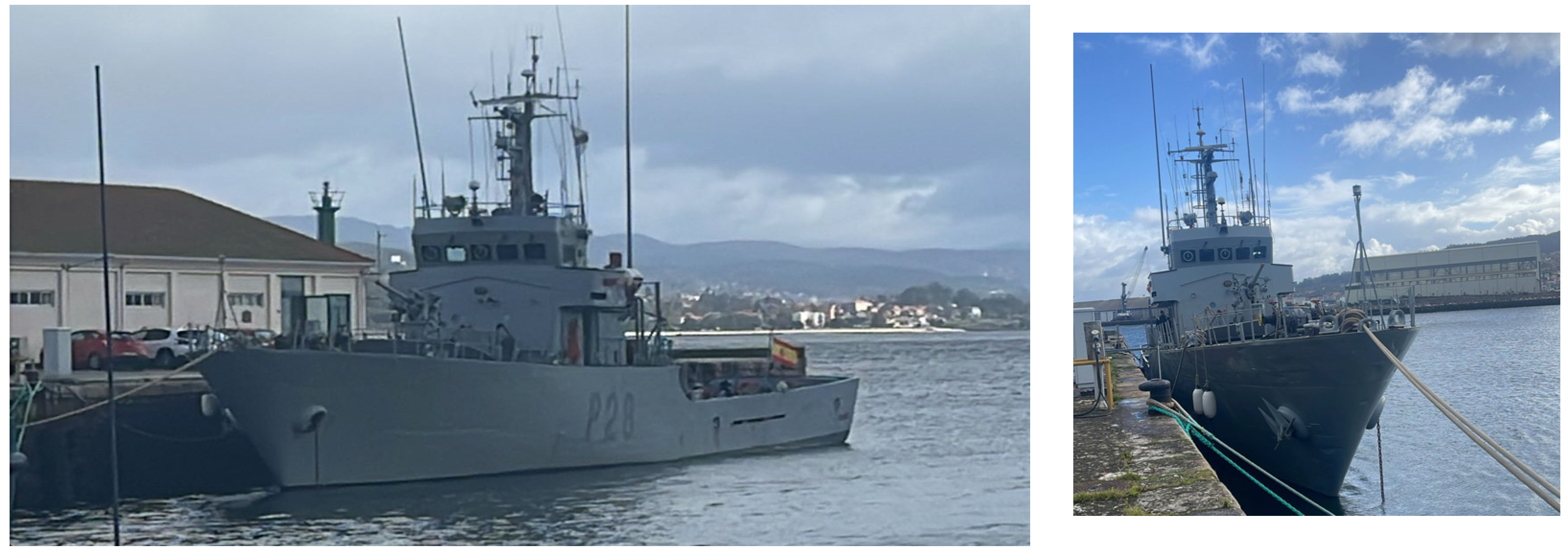
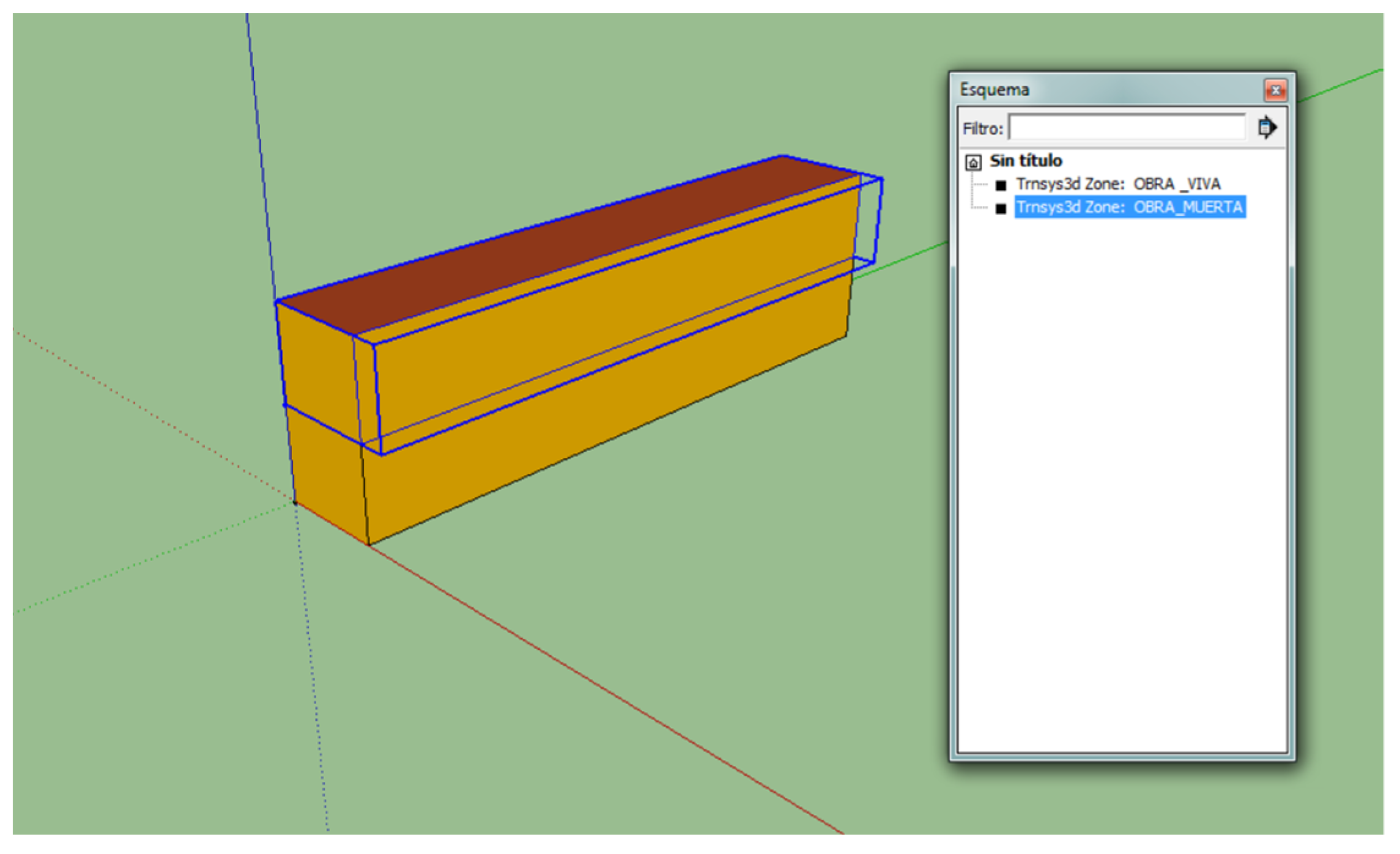



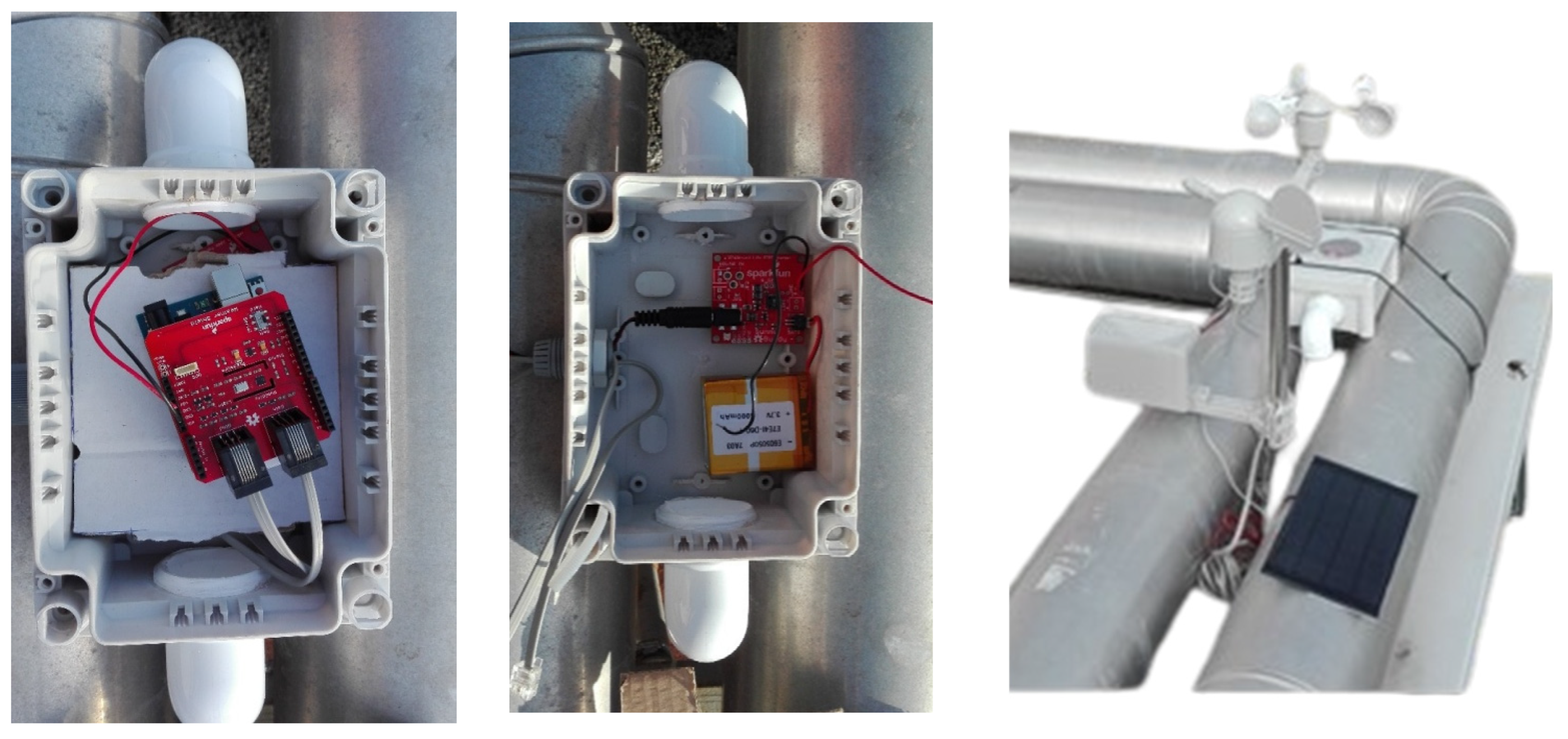
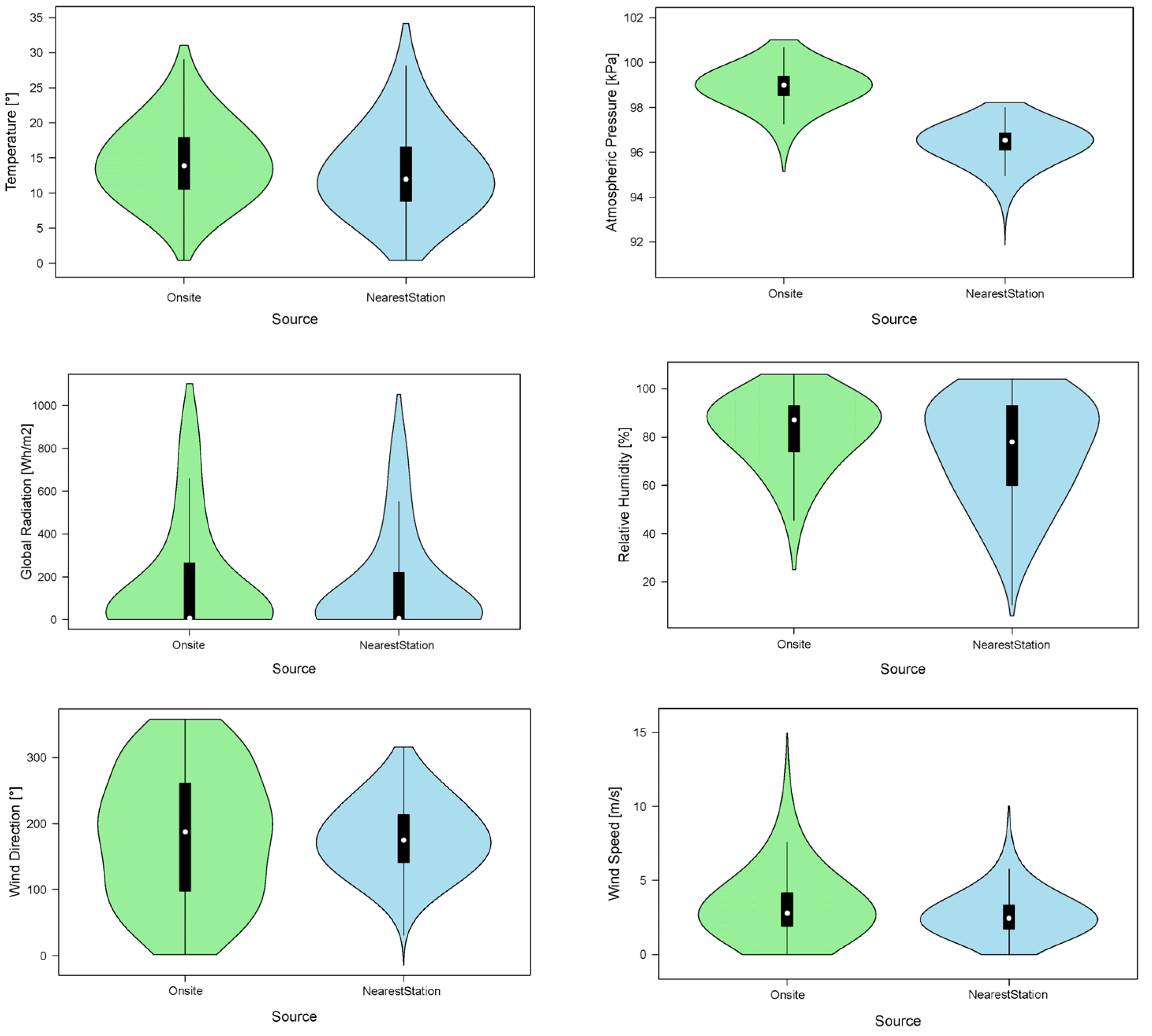
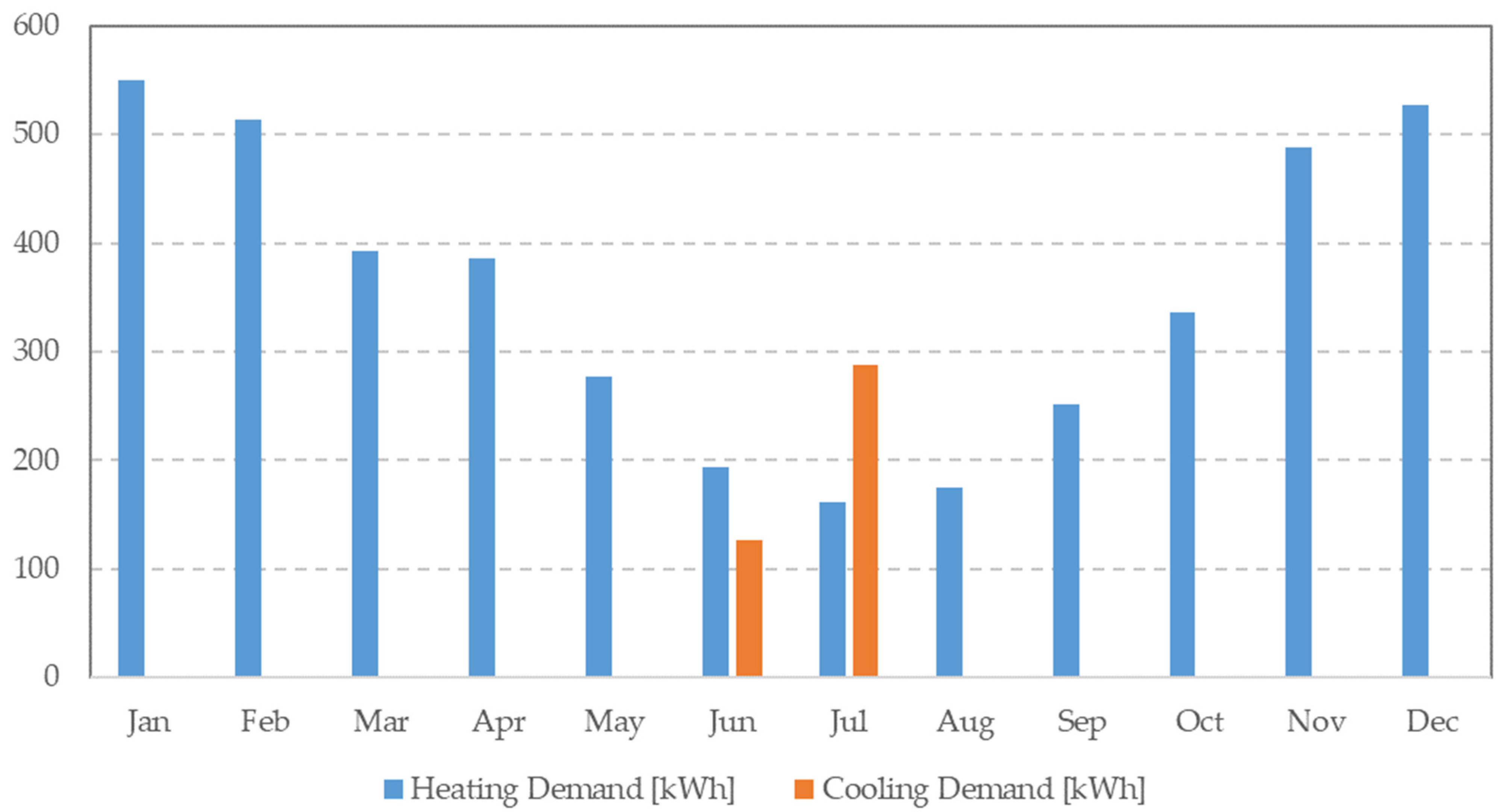
| Layer Type | Thermal Conductivity [W/m·K] | Capacity [kJ/kg·K] | Density [kg/m3] | Thickness [m] |
|---|---|---|---|---|
| Steel | 18.1 | 0.5 | 7800 | 0.007 |
| Insulating material | 0.14 | 1.0 | 50 | 0.050 |
| Measured Parameter | Sensor Used | Accuracy |
|---|---|---|
| Wind speed | Campbell 05106-5 MA (Campbell scientific, Logan, UT, USA) | ±0.3 m/s |
| Wind direction | Campbell 05106-5 MA (Campbell scientific, Logan, UT, USA) | ±3° |
| Barometric pressure | Vaisala PTB110 (Vaisala, Vantaa, Finland) | ±0.3 hPa at +20 °C |
| Global horizontal radiation | Kipp&Zonen CMP-3 (Kipp&Zonen, Delft, The Netherlands) | 20 µV/W/m2 |
| Temperature | Rotronic HygroClip HC2A-S3 (Rotronic AG, Bassersdorf, Switzerland) | ±0.1 °C |
| Relative humidity | Rotronic HygroClip HC2A-S3 (Rotronic AG, Bassersdorf, Switzerland) | ±0.8% |
| Electronics | Function |
|---|---|
| SparkFun RedBoard– Programmed with Arduino | Gather all the weather data |
| Electric Imp Shield | Connect hardware device |
| SparkFun Weather Shield | Measure barometric pressure, relative humidity, luminosity, and temperature |
| Shield Headers | Connect shield to Arduino board |
| RJ11 Connectors | Provide an input signal |
| Weather meter | Measure wind speed, wind direction and rainfall |
| Solar panel | Provide power |
| Lithium Ion Battery—6Ah | Storage energy |
| SparkFun Sunny Buddy— MPPT Solar Charger | Connect solar panel to battery |
| Variables | On-Site Station | MeteoGalicia Agency Nearest Station | MBE c | MAE d | ||||||
|---|---|---|---|---|---|---|---|---|---|---|
| M a | CV b | Range | M | CV | Range | |||||
| Min. | Max. | Min. | Max. | |||||||
| Temperature [°C] | 14.94 | 0.33 | 3 | 30 | 12.78 | 0.51 | 2 | 29 | −1.32 | 3.79 |
| Relative humidity [%] | 82.25 | 0.17 | 25 | 106 | 74.33 | 0.28 | 6 | 104 | −7.92 | 19.42 |
| Atmospheric pressure [hPa] | 989 | 0.01 | 951 | 101 | 964 | 0.01 | 918 | 982 | −2.57 | 2.54 |
| Global horizontal radiation [Wh/m2] | 173.03 | 1.55 | 0 | 1102 | 148.65 | 1.58 | 0 | 1052 | 24.38 | 83.63 |
| Wind direction [°] | 181.91 | 0.53 | 2 | 358 | 178.86 | 0.28 | −14 | 316 | 3.04 | 85.97 |
| Wind speed [m/s] | 3.23 | 0.65 | 0 | 11 | 2.88 | 0.54 | 0 | 10 | 0.64 | 1.90 |
| On-Site Station | MeteoGalicia Agency Station | ||
|---|---|---|---|
| Monthly demands Heating + Cooling [kWh] | January | 549.85 | 557.82 |
| February | 513.73 | 521.12 | |
| March | 393.18 | 406.42 | |
| April | 386.01 | 401.45 | |
| May | 276.83 | 284.73 | |
| June | 320.54 | 340.48 | |
| July | 449.92 | 490.40 | |
| August | 174.71 | 189.25 | |
| September | 251.49 | 268.08 | |
| October | 335.66 | 348.63 | |
| November | 488.69 | 497.99 | |
| December | 527.68 | 534.21 | |
| Annual demands | Total annual energy demand [kWh] | 4668.29 | 4840.60 |
| Annual energy demand [kWh/m2] | 46.68 | 48.41 | |
| Total annual difference [kWh] | 172 | ||
| Annual difference [kWh/m2] | 2 | ||
| Annual percentage difference | 3.69% |
Disclaimer/Publisher’s Note: The statements, opinions and data contained in all publications are solely those of the individual author(s) and contributor(s) and not of MDPI and/or the editor(s). MDPI and/or the editor(s) disclaim responsibility for any injury to people or property resulting from any ideas, methods, instructions or products referred to in the content. |
© 2024 by the authors. Licensee MDPI, Basel, Switzerland. This article is an open access article distributed under the terms and conditions of the Creative Commons Attribution (CC BY) license (https://creativecommons.org/licenses/by/4.0/).
Share and Cite
Arce, E.; Suárez-García, A.; López-Vázquez, J.A.; Devesa-Rey, R. Comparative Analysis of Meteorological versus In Situ Variables in Ship Thermal Simulations. Sensors 2024, 24, 2454. https://doi.org/10.3390/s24082454
Arce E, Suárez-García A, López-Vázquez JA, Devesa-Rey R. Comparative Analysis of Meteorological versus In Situ Variables in Ship Thermal Simulations. Sensors. 2024; 24(8):2454. https://doi.org/10.3390/s24082454
Chicago/Turabian StyleArce, Elena, Andrés Suárez-García, José Antonio López-Vázquez, and Rosa Devesa-Rey. 2024. "Comparative Analysis of Meteorological versus In Situ Variables in Ship Thermal Simulations" Sensors 24, no. 8: 2454. https://doi.org/10.3390/s24082454
APA StyleArce, E., Suárez-García, A., López-Vázquez, J. A., & Devesa-Rey, R. (2024). Comparative Analysis of Meteorological versus In Situ Variables in Ship Thermal Simulations. Sensors, 24(8), 2454. https://doi.org/10.3390/s24082454





